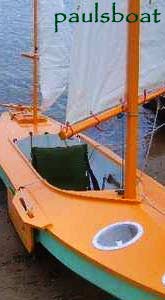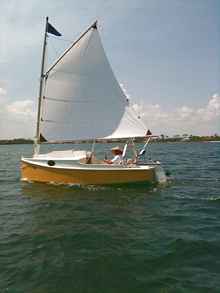
 Custom Search
|
|
| sails |
| plans |
| epoxy |
| rope/line |
| hardware |
| canoe/Kayak |
| sailmaking |
| materials |
| models |
| media |
| tools |
| gear |
 |
 |
| join |
| home |
| indexes |
| classifieds |
| calendar |
| archives |
| about |
| links |
| Join Duckworks Get free newsletter Comment on articles CLICK HERE |
|
|
| Thoughts of a Lazy Sailor, Twin keels |
by Patrick Johnson
- Wellington, Florida - USA |
After finishing a Skat design by Jim Michalak, I decided I needed a bigger boat for spending any practical time on the water doing over nights; I had owned a Menger Catboat some years ago and really liked that boat a lot. So my research brought me around to the Fat Cat Design. With the plans in hand and some pictures from the Internet I started my presentation to my wife on what was to be my 13th build. First words out of her mouth was, If it is going to have that stupid lee board you'll never see me in it. I knew she meant it. I didn't like the lee board look either and set out to design some sort of centerboard. Nothing I could come up with worked with the balance of the sail and the bulkhead arrangement. I had liked what I saw in one of Paul Fisher's designs called Ptarmigan 15. So I shot an email to him and he sent me back a brochure of the boat that showed a picture of someone that had built the boat using bilge keels. I liked the thought but they seemed to deep for my shallow south Florida water so I kept thinking and looking. I'm not sure how I connected with Bob Throne on the twin keel idea, I think I asked for Ideas on the Michalak group, but his process of shallow keels he had used on 'Wanderer' seemed like the cats meow for a cat boat. First thing I realized is how little I liked to have to fuss with pulling up a centerboard along with getting my rudder up so I didn't snap something off as I came into the beach. I did some more research after communicating with Bob on his twin keel idea and the only thing I changed was to put the keels on at a 15 degree angle, sloped out, because a couple of twin keel boat makers had a good argument as to why that would work well.
After doing sail 'center of' type geometry (which I got from Jim Michalak's newsletter) I determined that the two boards would need to have about a total of 5 square feet of surface to offset the leeboard that Jim had drawn for the boat. Being afraid of lee helm I moved my center of effort 9 inches forward of the centroid of the sail. Just because I felt like I could add to the aft end easier than the forward end of the twin keels if I needed to adjust. I had had Dave Gray build me a polysail that was a little reduced in size to the original sail and he had marked the center for me so it was pretty easy to figure out. The slats were made from yellow pine. They were cut out with the 15 degree angle on both sides leaving them a full 1 ½ inches wide in the center. The bottom of the boat is ¾ inch thick so I just used deck screws and titebond III glue and screwed them one on top of the other. I cut the leading and trailing edge off at 45 degrees. Rounded over the edges and epoxy glassed them onto the boat. I figured if the whole thing didn't work out, I'd just get the saws all out and start over with the leeboard.
The first sail was done in really light air and I have to say I was a little disappointed in the results. She just wouldn't point like I wanted. Wind speed was so nonexistent that you couldn't see any in the trees or weeds. The next sail had about 7 to 10 miles per hour wind and it made a lot of difference. The boat took off like it was supposed to be a sail boat holding about 50 degrees off the wind on both tacks. I thought that was really good for such light air and hurried home to tell my wife of the good thing. She came with me on the next sail and we had a nice breeze that day. The boat liked the breeze and just worked great on all points of sail. A few days later my son and I went out in some 25 mph + wind with both reefs in and she still preformed great. I was ready for the FL 120. When I arrived the evening before the event in Pensacola, Fl. the raging storm sort of made me rethink what in the heck I was doing. I put the boat in early that morning and took off for the first meeting point. It was a little bit of a close-hauled tack but the boat did great. I made it to the island that we were going to camp at about the middle of the pack and had several people come up and talk to me about the boat. I think if people wanted to use this system on thinner boats it would even work better. The Fat Cat design is 15ft. long and 6 ft. wide. I have a queen size mattress in the stateroom. Leaving the first island and heading to the next was going to be a lot of sailing for one day. I think it was over 40 miles. Tom Willey in his beautiful 'Mayfly 14' took off a little before me and it was a great down wind run the whole day. I even caught up with Tom and passed him. Since we were the first guys out of the gate that morning I got to take the lead for a little while until the sea pearls woke up. The boat was hitting 6.4 knots from time to time and I had a blast.
This is the twin keeled Fat Cat that got the name 'Kat Kan Dew!' from the experience of the FL120 (picture by Pat Johnson of Pensacola). My thanks to everyone that helped me with the project. I can't imagine using anything but shallow keels on any boats I build in the future. Which will probably be a Ptarmigan 17. Patrick Johnson |
 |




